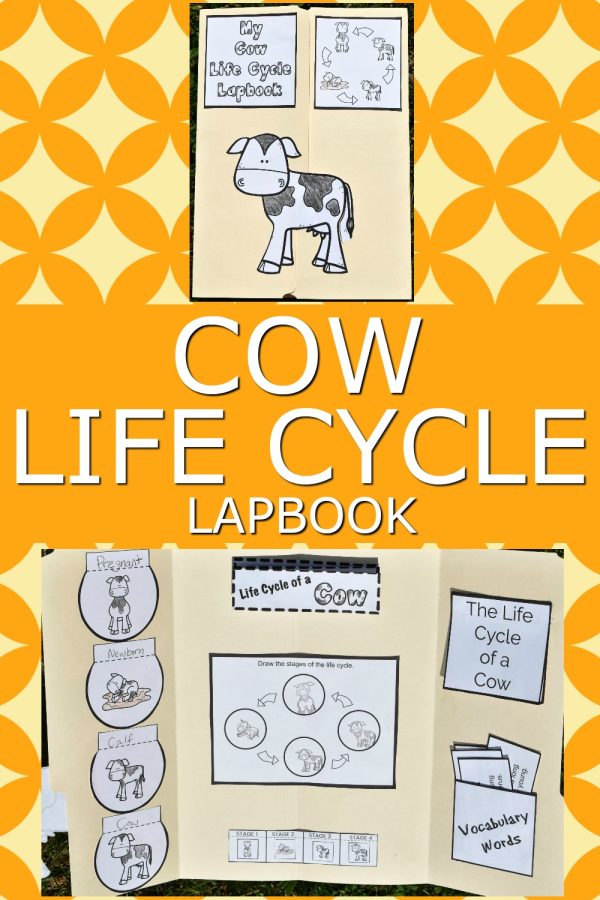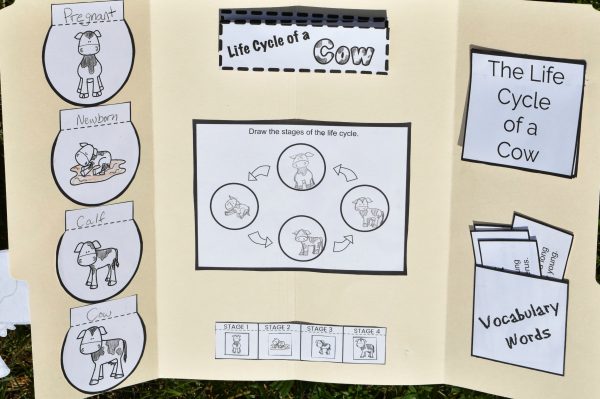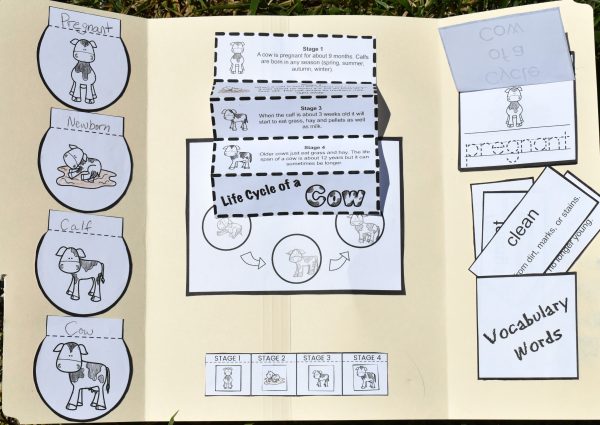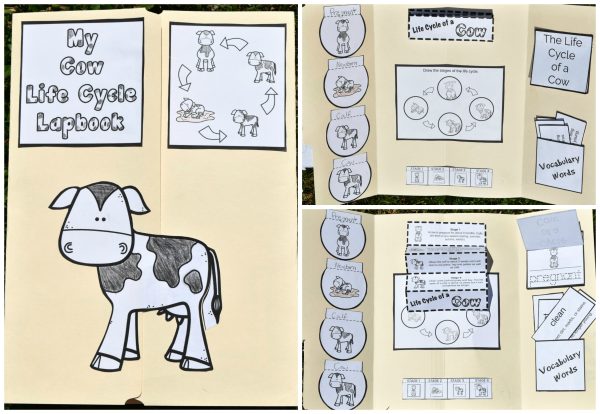Life Cycle of a Cow Diagram (Free Printable)
Cows are incredible animals that play an important role in our lives. From providing us with milk for our breakfast cereal to becoming delicious burgers, cows have a significant impact on the food supply chain. But have you ever wondered how a cow’s life unfolds, from the moment it’s born to when it becomes a mature cow? In this blog post, we’ll explore the life cycle of a cow, breaking it down into simple stages. Plus, we have a free Life Cycle of a Cow Diagram Printable to make learning about cows even more fun!
Whether you’re a teacher, homeschooling parent, or caregiver, Educational Printable Resources are a valuable tool for reinforcing concepts and providing additional practice for students.

Table of Contents
What is the life cycle of a cow?
- Stage 1: Pregnant
Every cow’s journey begins with the female cow being pregnant. Just like humans, cows go through a pregnancy called the gestation period. This is the time when a cow carries a developing baby calf inside her. During this stage, the cow’s body releases hormones like gonadotropin-releasing hormone and estrous cycle that help her get ready for motherhood. Pregnant cows carry their developing fetus for around nine months. - Stage 2: Newborn
After about nine months of waiting, it’s time for the exciting moment: the birth of a newborn calf! This little calf is the result of a developing embryo inside the mother’s womb. It’s a small living thing that needs care and love to grow strong and healthy. The calf usually weighs around 60 to 100 pounds and is 3 to 4 feet tall. A calf can stand up and even walk shortly after birth. During the first few months of life, a calf relies on its mother’s milk for nutrition. As it grows, it will start to eat solid food like hay and grass. - Stage 3: Calf
As the calf grows, it’s called a heifer calf if it’s a girl or a bull calf if it’s a boy. During this time, calves are fed their mother’s milk, filled with essential nutrients. They also learn to graze on grass and other food. Calves have a special connection with their mothers, getting all the nutrients they need from their mother’s milk. - Stage 4: Cow
After about two years, the calf has turned into a young cow, also known as a heifer. During this stage, the cow’s body goes through changes, and it’s getting ready for an important function: making its milk. Cows that produce milk are called dairy cows, while those raised for meat are known as beef cattle. The cow’s body weight and nutritional needs are carefully managed to keep her healthy and strong. At this stage, cows are fully grown into mature cows and can weigh up to 1,500 pounds. They are also able to reproduce and have their calves. Adult cows spend most of their time eating and resting. They can live up to 20 years, but the average lifespan of a cow is around 5 to 6 years.

How do you assemble this life Cycle of a Cow Diagram?
Supplies Needed:
Crayons, Markers, or Colored Pencils
Scissors
The life cycle of a cow printable (Get the free Resource at the bottom of this post)
To create the cover of the printable lap book, color each item on the page. When finished, cut each item out and glue it to the desired spot on the front flaps of the lapbook.
Cut out the ‘Vocabulary Words” square. Cut the lines with the word ‘cut’ beside them. Fold on the dotted lines. Glue the folded areas and put them in the desired area in the printable lapbook. Cut out the vocabulary cards and put them in the “Vocabulary Words” pocket.
Labeling Circles – Cut out each circle (with the blank label area on top) with pictures of each step of the life cycle. Label and glue them in the correct order on one side of the lapbook.
Blank Life Cycle – Cut out the square with the blank life cycle and glue it in the desired area in the center of the lapbook. Have your students draw the life cycle steps in each circle in the correct order.
Life Cycle of a Cow Diagram Printable

Stages 1-4 Square – Cut out the square with the Stages 1-4. Glue it to the lapbook. Then, color and cut out the individual squares with each step of the life cycle. Glue them in the correct order from Stage 1 to Stage .4
Tracing Words Printable Flapbook – Cut out each page of the tracing words flapbook. Glue them together in the correct order using the top line as a guide to put the glue. Have your students trace the words) on each page and say them aloud.
Cows are versatile animals that can thrive in a variety of habitats. They are well adapted to living on farms and ranches, but they can also be found in the wild in many parts of the world. Whether they are living in a domestic or wild setting, cows require access to food, water, and shelter to survive.
The life cycle of a cow is divided into several stages, from conception to death. Each stage is marked by specific physical and behavioral changes that are important to understand. For instance, a newborn cow is called a calf, and it is entirely dependent on its mother for food and protection. As it grows, it becomes a heifer, and then a cow, capable of producing milk and giving birth to calves. Finally, in old age, a cow’s productivity declines, and it is eventually culled for meat.

Cows are fascinating animals that have been domesticated for centuries. They play a vital role in our lives by providing us with food, leather, and fuel. Understanding the life cycle of a cow is important for both children and adults. In this article, we will explore the different stages of a cow’s life, its habitat, diet, and role in the ecosystem.
Understanding cows is not just about their life cycle, but also their habitat, diet, and role in the ecosystem. Cows are social animals that live in herds and graze on grass and other vegetation. They play an important role in maintaining the balance of the ecosystem by converting plant matter into food for humans and other animals. Additionally, cows are an essential part of many cultures around the world and are revered for their contribution to human society.
Life of a Cow Diagram Printable
Cows are domesticated animals that are commonly found on farms. They are known for their gentle nature and their ability to produce milk. Understanding cows is important for children to learn about where their food comes from and how it is produced.
Physical Characteristics – Cows are large animals that can weigh up to 2,000 pounds. They have four legs, a tail, and two ears. Their bodies are covered in hair, and their skin can be different colors, such as brown, black, or white. Cows have a large stomach with four compartments that allow them to digest their food properly.
Life Cycle – A cow’s life cycle begins when it is born as a calf. Calves are usually born weighing around 60-100 pounds and can stand up and walk within an hour of being born. They drink their mother’s milk for the first few months of their life and then start to eat solid food.
As they grow, cows go through different stages of life, such as heifer, cow, and bull. Heifers are female cows that have not yet had their first calf, while cows are female cows that have had at least one calf. Bulls are male cows that have not been castrated.
Milk Production – Cows are known for their ability to produce milk, which is used to make dairy products such as cheese, yogurt, and ice cream. A cow can produce an average of 6-7 gallons of milk per day, but some cows can produce up to 20 gallons of milk per day.
To produce milk, cows need to be milked regularly. This is usually done using a milking machine, which is attached to the cow’s udder. The milk is then collected and stored in a tank until it is ready to be processed.
Life Cycle of a Butterfly Printable
10 Stages of a Strawberry Life Cycle
Praying Mantis Life Cycle (Free Printable)
Reproduction Life Cycles of a Cow
Cows can reproduce when they reach adulthood. Female cows, called heifers, can start having calves at around 2 years of age. Male cows, called male bulls, can start breeding at around 1 year of age. Cows are pregnant for approximately 9 months and give birth to a single calf. After giving birth, cows will continue to produce milk for their calf and can be milked by farmers for human consumption.
As cows age, they become less productive and their bodies start to deteriorate. They may develop health problems and become less able to move around. When a cow reaches the end of its life, it is usually sent to a slaughterhouse for meat production. However, some cows are allowed to live out their natural lives on farms or in sanctuaries.
Cows go through several stages of life after birth, starting as a calf, reaching adulthood, reproducing, and eventually reaching old age. Each stage of a cow’s life is important and contributes to the overall life cycle of these animals.
What do Cows Eat?
Cows are herbivores, which means they only eat plants. Their diet mainly consists of grass and hay. However, the diet of a cow changes as it grows from a calf to an adult cow.
Calf Diet – When a calf is born, it relies on its mother’s milk for the first few months of its life. The milk is rich in nutrients and helps the calf grow and develop. After a few months, the calf starts eating solid food such as hay and grass. The calf’s diet gradually shifts from milk to solid food as it grows.
Adult Cow Diet – Adult cows have a more complex diet than calves. They eat a variety of plants, including grass, hay, silage, and corn. They also need a lot of water to stay hydrated. Full-grown beef cows can drink up to 50 gallons of water a day.
In addition to their main diet, cows also need minerals and vitamins to stay healthy. Farmers often provide supplements to ensure that their cows are getting all the nutrients they need. These supplements may include salt, calcium, and phosphorus.
It’s important to note that cows have a unique digestive system that allows them to break down tough plant material. They have a four-chamber stomach that ferments and breaks down their food. This process allows cows to extract all the nutrients they need from their food.
The diet of a cow is simple yet essential for their growth and health. Cows need a balanced diet of plants, minerals, and vitamins to thrive.

What is the Habitat of a Cow?
Cows are domesticated animals that are found all over the world. They are adaptable to different environments and can live in various habitats. Cows are often raised on farms or ranches, where they have access to food, water, and shelter.
In the wild, cows can be found grazing on grasslands, meadows, and even in forests. They prefer areas with plenty of vegetation and access to water sources. Cows are social animals and often live in herds, which can range in size from a few individuals to several hundred.
Cows are well adapted to living in different climates. They can tolerate both hot and cold temperatures, but they need access to shade and shelter to protect them from extreme weather conditions. In hot climates, cows may seek out water sources to cool off, while in colder climates, they may huddle together to keep warm.
Dairy farms and Dairy Cattle can have a significant impact on the life cycle of a cow. Here are some ways:
1. Reproduction: Dairy cows are bred for milk production and are often artificially inseminated to ensure that they give birth to a calf every year. This frequent breeding can put a lot of stress on their bodies, and it can lead to health problems and a shorter lifespan.
2. Milk production: Dairy cows are milked two to three times a day, which can be a painful and uncomfortable process for them. This constant milking can also lead to udder infections and other health issues.
3. Diet: Dairy cows are often fed a high-energy diet to maximize their milk production. This diet can cause metabolic disorders and other health problems, such as lameness and reproductive issues.
4. Slaughter: When dairy cows are no longer able to produce enough milk, they are often sent to slaughter for their meat. This can happen when they are still relatively young, which means that their life cycle is much shorter than it would be in a natural setting.
The life cycle of a dairy cow is heavily influenced by the demands of the dairy industry, and it can be a challenging and stressful existence for these animals.
Cows play an important role in the ecosystem. They help to maintain the balance of the ecosystem by grazing, providing natural fertilizer, and contributing to carbon sequestration. Farmers and other individuals who work with cows should be aware of their important role in the environment and take steps to ensure that they are treated with care and respect.
Cows can also help to reduce the amount of carbon in the atmosphere. As they graze, they help to maintain the health of the grass and other vegetation. This, in turn, helps to absorb carbon dioxide from the atmosphere and store it in the soil. This process is known as carbon sequestration and is an important way to reduce the amount of greenhouse gases in the atmosphere.
The life cycle of a cow in North America can vary depending on its intended use and management practices but typically involves several stages of growth and development before being sold or processed for meat.
What are the stages in the life cycle of a cow?
The life cycle of a cow has four stages: pregnant, newborn, calf, and cow. A calf is a newborn cow that is less than three months old. A heifer is a young female cow that has not given birth to a calf yet. A cow is a mature female cow that has given birth to a calf. A bull is an adult male cow that is used for breeding.
What are the different stages of beef production?
Beef production has three stages: cow-calf operations, stocker and backgrounding, and feedlot. Cow-calf operations involve breeding cows and raising calves until they are weaned. Stocker and backgrounding involve growing the weaned calves until they are ready for the feedlot. The feedlot is where the calves are fed a high-energy diet to promote rapid growth and weight gain.
Understanding cows is important for children to learn about where their food in the grocery store comes from and how it is produced. Cows are gentle animals that are known for their ability to produce milk, and they go through different stages of life as they grow.
It is important to understand the life cycle of cows to appreciate the hard work that goes into producing the products we consume. By learning about cows, children can develop an appreciation for the animals and the farmers who take care of them.
Cows have a truly amazing journey in their lives. From being born as tiny calves to growing into strong cows. Learning about cows can be super fun so keep exploring, keep learning, and who knows, maybe one day you’ll even visit a real farm to see these amazing animals up close.
